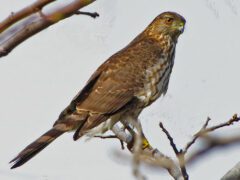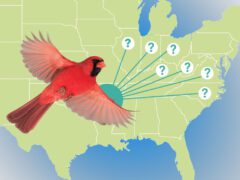Long-eared Owls are medium-sized, slender owls with long ear tufts. The head, roughly as wide as it is long, looks squarish. The facial disks are long and narrow.
Relative Size
Smaller than a Great Horned Owl, larger than a Western Screech-Owl.

 crow-sized
crow-sizedMeasurements- Both Sexes
- Length: 13.8-15.8 in (35-40 cm)
- Weight: 7.8-15.3 oz (220-435 g)
- Wingspan: 35.4-39.4 in (90-100 cm)
- Length: 13.8-15.8 in (35-40 cm)
- Weight: 7.8-15.3 oz (220-435 g)
- Wingspan: 35.4-39.4 in (90-100 cm)
























